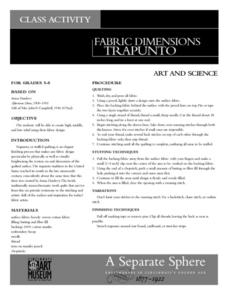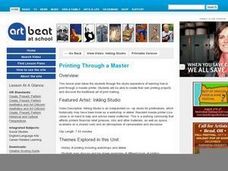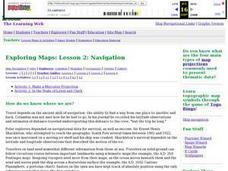Curated OER
Blue Planet: Tidal Seas
Students investigate how tides affect sea life. In this video based instructional activity, students view a video on how tides affect sea life. They do web-based research to find the answers to a series of questions and then play Tidal...
Curated OER
Glaciers and Icebergs
Students conduct an experiment on glacial scraping. In this glacial scraping lesson, students create a small glacier in a plastic cup. Students remove the cup and scrape the glacier across wood and note the markings. Students then make...
Teach Engineering
Stormy Skies
Young meteorologists examine the four main types of weather fronts and how they appear on a weather map. Participants learn about the difference between the types of weather fronts along with their distinguishing features. A...
Pennsylvania State University
Learn, Protect, and Promote Water
A hands-on activity helps learners explore the water cycle. After discussing how they use water, classes discuss water pollution and then move into a simulation where 20 pupils move through the water cycle based on description cards.
Teach Engineering
Projections and Coordinates: Turning a 3D Earth into Flatlands
Introduce your class to map projections and coordinates, the basics for the work done in a GIS, with an activity that uses Google Earth to challenge learners to think about the earth's shape.
Teach Engineering
The Amazing Red Planet
Introduce your class to Mars with a resource that provides information about its size, location, length of day, length of year, number of moons, and average temperature. Also includes is information about the lans for past and future...
Curated OER
Relief Drawing
High schoolers choose an interesting view for an art relief project. They outline their composition, and shade their relief using charcoal pencil. The results are fabulous! One nice thing about this art project is that the materials...
Curated OER
The Energy of Light
Students discuss different ways engineers use light. In this engineering lesson, students are introduced to the properties of light and the way light is used. They view a demonstration of light waves using a slinky, and practice using...
Curated OER
Fabric Dimensions
Young scholars create original examples of the trapunto quilting technique in this middle-level lesson sutied for the Art classroom. Assessment and discussion questions are included for this lesson.
Curated OER
Iron Fertilization - Pumping Iron
The theory that adding iron to ocean water may increase phytoplankton ability to remove carbon dioxide from the atmosphere is examined. The Monterey Bay Aquarium Research Institute is monitoring conditions off the California coast to...
Curated OER
The Ozone
Young scholars engage in lesson concerned with the concept of the ozone layer. They write a reflective journal using prior knowledge. Students read sources of information about the existence of a hole in the ozone layer. Finally they...
Wild BC
The Greenhouse Effect: The Role of CO2
Though this is meant to be second in a two-part lesson, the two are not dependent on each other. Pupils play the roles of visible light rays, light or dark surfaces, and carbon dioxide molecules. They interact and react according to...
Curated OER
Antibiotic Resistance
Students using the scientific method, study bacteria as a covering surface of the earth in many forms. They discover that not all bacteria is bad and introduce the topic of antibiotic resistance. Science Fair expectations are addressed.
Curated OER
Printing Through a Master - Activity 1
Students discover the art of printmaking in this introductory instructional activity provided by Oregon Public Broadcasting. Emphasis is placed on the history of the art and master printer Liza Jones.
Curated OER
Malta: The Landscape
Students work in small groups to create a topographic map of Malta. They must include labeled line drawings of bordering countries and bodies of water. Students use salt and flour clay to make Malta three dimensional, showing the nearest...
Curated OER
Shake, Rattle and Roll
Students explore how to locate the location of an earthquake and why earthquakes happen more frequently in some areas more than others.
Curated OER
Energy and Energy Conversion
Third graders investigate different energy conversions through hands-on activities. In this energy lesson, 3rd graders move through four stations and conduct experiments illustrating energy conversions. Wave energy, chemical energy,...
Curated OER
Go Fish
Here is a good art lesson on creating colorful versions of fish. After studying images of a variety of fish, young artists choose one that they want to create an image of. Using some high-quality materials, they create their masterpieces...
Curated OER
Hungary: The Landscape
Students work in small groups to create a topographic map of Hungary. The map will include labeled line drawing of the bordering countries. Hungary should be three dimensional, made of salt and flour clay. The mountains, plains and...
Curated OER
Italy: The Landscape
Learners work in small groups to create a topographic map of Italy. They must include labeled line drawings of bordering countries and bodies of water. Students use salt and flour clay to make Italy three dimensional, showing the many...
Curated OER
Lead Up Skills fo Tchoukball
A simple lesson to practice the throwing and catching skills for the game of Tchoukball. There are several warm-up activities to have the class practice tossing a ball around. Then the main drill is organized much like a basketball...
Illustrative Mathematics
Shape Hunt Part 1
The hunt is on! Send young mathematicians on a search for shapes in the first lesson of this two-part series. Each time a child finds a hidden shape, he draws it on his paper, and continues searching for the rest. Perform this activity...
Curated OER
Social Studies: Looking at Regions
Quiz your 3rd graders on why we have regions. This regions quiz includes 16 questions on why and how we group areas into regions based on physical features, culture, politics or religion. A class discussion on technology completes this...
Curated OER
Exploring Maps: Navigation
Learners engage in a activity that is concerned with the concept of navigation while research is conducted with the use of a variety of resources. The information is used to expand their perspective of the applications for navigation....

























